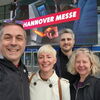Processing Your Payment
Please do not leave this page until complete. This can take a few moments.
The Gourmet effect | National press coverage has a big payoff for Maine restaurants
Immediately, Evans said, his business tripled. It was so busy, in fact, that he opened his second restaurant, Duckfat, from profits generated by the award and subsequent article. "It was crazy," Evans said. "There was Hugo's before Food & Wine, but Hugo's and Duckfat after. It made that much difference."
While Evans' example is extreme, he's far from the only Maine restaurateur to get attention from the national food media. Sam Hayward, chef/owner of Portland's Fore Street and winner of the venerable James Beard Foundation award for best Northeast chef in 2004, is a perpetual magazine subject. Thought by most in Maine's restaurant business to be the father of Maine cuisine, his dedication to local purveyors and the fine Maine ingredients they sell has made him a star in the press and a respected figure in kitchens across the state.
This month's issue of Food & Wine contains the most recent in a lengthy string of articles about him, a short profile of Hayward, along with the recipe for Fore Street's signature Bang's Island Mussels. But the press surge isn't focused solely on Maine's most famous chefs and eateries. Last month, the Road Food column in Gourmet profiled Moody's Diner in Waldoboro and Cole Farms in Gray. And in June, Food & Wine named Portland "Where to Go Next" in the United States, an important article that included a few of the area's newest ˆ and smallest ˆ food destinations, as well as perennial favorites like Hugo's. The effect this press has on Maine's better-known restaurants varies, ranging from bursts of summertime tourist business for new places to spots on national television shows for more established ones.
According to the Washington, D.C.-based National Restaurant Association, America's restaurant business is a hefty one, generating an estimated $476 billion in annual sales among the 900,000 NRA-registered eateries. On average, Americans dine out 54 billion times a year, with families spending roughly $800 per person, per year. That's a sizable chunk of people's paychecks being forked into the food industry.
What draws customers in the first place, however, is somewhat of a mystery. Word-of-mouth approval and advertising rank high on the list of attention-grabbers. But the question remains: What effect does media attention have on customers' dining choices?
Though the NRA briefly noted in a 1998 study that "certain press" can increase restaurant sales between 20% and 50%, more precise ˆ or more current ˆ data is difficult to find. Still, some clues can be found on the Magazine Publishers of America's list of the top 100 magazines by circulation each year. Gourmet and Bon Appetit, for instance, ranked among the top 25 in 2004 with just over a million readers nationwide.
For small restaurants like Hugo's, a positive writeup equals free exposure to at least a million food-loving folks. Though perhaps only a relative handful of those million readers might travel to Maine just to try a restaurant, the greater impact is deep. A restaurant's reputation often travels fastest via word-of-mouth, and being mentioned in a national magazine guarantees discussion. For out-of-state readers, that might equate to adding Maine and a few of its featured restaurants to next summer's vacation agenda. For locals, reading about their regular breakfast spot can be a source of pride, inspiring them to invite friends, family and co-workers to experience it as well. Over time, these factors add up to greater ˆ and more varied ˆ business. Not only that, but even the tiniest feature in a magazine from the culinary canon can permanently place a restaurant on journalists' radar ˆ often leading, as Evans experienced, to additional exposure.
Don't forget the locals
Steve Corry, chef and co-owner, with his wife, Michelle, of 555 in Portland, doesn't advertise the couple's two-year-old restaurant. When they opened their airy, two-floor space on Congress Street, they considered it briefly, but decided that they didn't know where to invest. "Everyone came by to pitch ad ideas," Steve Corry said. "Radio, local press, TV. We had too many options, and not much money. We decided against it."
So when they were first written up in the now-defunct Organic Style as one of 2004's top 20 new organic restaurants in the country, and again last June in Food & Wine's "Where to Go Next" feature, it came as a complete surprise. "We wonder where [the press] comes from," Corry said. "We're happy to have it, but we're just amazed that we get it [without advertising]."
Also amazing, he says, is the effect it had on their business. This past summer was a stellar one for 555, according to Corry, with both articles bringing people in from as far away as California. "People would call for reservations and say 'I read about you in Food & Wine.'" Corry said. "It really boosted our tourist-season business."
Still, Corry insists that the only way to guarantee success on any level is to keep local diners happy. "It's the guy who walks here from his house two blocks away during a snowstorm that really matters," Corry said. "Our regulars, that's who the focus is on." Corry said he serves those locals by continuously delivering creative dishes that incorporate the freshest ingredients Maine has to offer while maintaining affordable prices.
Corry's focus on the importance of the local community is understandable ˆ after all, when summer is through and the tourists have left for the season, it's the local business that keeps a restaurant going through the winter. And the local press has a significant amount of influence in helping to secure this regular clientele. Reviews in the Maine Sunday Telegram and the Portland Phoenix, for example, serve to notify consumers of new and interesting places to eat.
Alternatively, a profile in Down East or Yankee magazines ˆ two New England publications that boast subscribers from across the country ˆ offer local diners an in-depth look at an establishment. Often, such profiles will also draw the initial attention of magazines like Food & Wine or Gourmet. Rob Evans cites Hugo's 2003 Down East profile as the first important step toward national recognition. "Everyone who comes to Maine reads Down East," Evans said.
Steve Corry agrees; granting local publications as much power as national ones in the perpetuation of a restaurant's reputation. "We've had our share of local bits," Corry said. "I certainly think that those bits are just as important, if not more so. They add up."
Corry's sentiment about the importance of local diners is echoed by Josh Potocki, co-owner and chef at One Fifty Ate in South Portland, a restaurant also included in the June Food & Wine article. "We're in a groove, focusing on the food for the people who come in here every day," Potocki said. "It's not about the tourists and the [national] press."
What began four years ago as a bakery/café by day for Potocki and his partner Allison Reid has blossomed into an intimate 10-table dinner spot at night ˆ a spot that, after the Food & Wine article, had some people making reservations three to four months in advance. Surprised by their sudden ˆ and un-courted ˆ brush with national-press approval, Potocki and Reid have vowed to remain locally focused and to simply hope for the best when it comes to more national exposure. "[Food & Wine] helped with our summer, for sure," Potocki said. "But if we keep making solid food, we hope we'll keep getting press and the whole thing will just snowball."
That snowball may already be forming: Potocki says a feature in the November issue of Down East is already bringing throngs of customers into One Fifty Ate.
Though most restaurants do not actively seek national press coverage by employing publicists or delivering press kits to major magazines, there are hidden beneficial factors at work ˆ namely the writing of Maine-based food journalists like Nancy Harmon Jenkins. Jenkins writes for Food & Wine and penned the "Where to Go Next" article that served as a national debut for 555 and One Fifty Ate. Jenkins, who lives in Camden for part of the year, has been attuned to the changing face of Maine's culinary future for close to 10 years. She was one of the first to uncover Sam Hayward's talents on a national scale, and has maintained a connection with Maine's food scene ever since. Many Maine restaurateurs see her as an important catalyst for Maine restaurants' growing national prominence. "[Jenkins] brought attention to Sam," Potocki said, "and that opened up chances for the rest of us."
Only as good as the last burger
Becky Rand, owner of the landmark Becky's Diner, is unfazed by the attention her 15-year-old Portland restaurant has received over the years. "We've been successful for so long because of our food and our service," Rand said. "Plain and simple." It's her dedication to these things that Rand believes qualified Becky's for the honor of being named one of America's Top 10 Diners by Bon Appetit online last month.
But Becky's Diner's press history is vast and Rand knows the snowball effect well. "We started with constant local write-ups," Rand said. "And then a big article in Gourmet in 2003. After that, it just exploded. We've been in cookbooks, travel books, newspapers ˆ you name it." Rand noted that she has never employed a publicist or courted journalists, claiming most of her press exposure is a result of "sheer luck."
A recent coup was a feature on the diner on the Food Network's $40 a Day with Rachael Ray. The episode, which focused on Rand's famous blueberry pancakes, first aired last winter, spurring calls from across the United States and Canada from people seeking autographed menus, hats and mugs. "It legitimized our little diner," Rand said. "We're just so lucky."
Today, Rand is awaiting the December publication of an article about her "little diner" in Source Magazine, which is mailed to five million Sam's Club members each month. "We might be on the cover," Rand said. "I think that's gonna be really neat ˆ knowing five million people are reading about [Becky's]."
In the end, though, Rand gives all the credit to her customers and the food they've come to depend upon. By adhering to old family recipes and using fresh ingredients whenever possible, Rand believes she's captured the trust of locals seeking good food. "Locals are the key," Rand said. "They keep my employees employed and a roof over my head. Whatever they want, we try to give them."
According to Miles Henry, co-owner of the Maine Diner in Wells, what people want, whether they're locals or not, is "good, consistent food and great service."
The Maine Diner is one of Maine's most decorated national-press veterans. Opened in 1983, it received write-ups in Down East, Gourmet and Bon Appetit "sometime in the mid-80's," Henry said. In 1985, Jane and Michael Stern mentioned the Maine Diner in Roadfood, a compendium of the best in traditional American diners, food stands and small restaurants. By September 1997, the diner, and its famous lobster roll, was featured on the Today show. The Maine Diner achieved all of this early success with Henry serving as its publicist, conducting interviews and placing what little advertising he and his brother could afford for their young business.
Since then, the Maine Diner has grown to include a gift shop, a detailed website and a dining room jammed with 90 seats. In fact, they've expanded so much that Henry worries about another bulge in business. "We can't grow much more." Henry said. "We just don't have the room."
Henry fully acknowledges the influence of the press in the success of his restaurant and is excited about the diner's newest piece, a December feature in Delta Airlines' in-flight publication, Sky Magazine. However, Henry stresses the importance of maintaining quality and says that no matter how publicized a restaurant is, the only focus should be on the food. "After all, people don't really remember you," Henry said. "They only remember the last burger they ate at your restaurant."
Read more










Comments